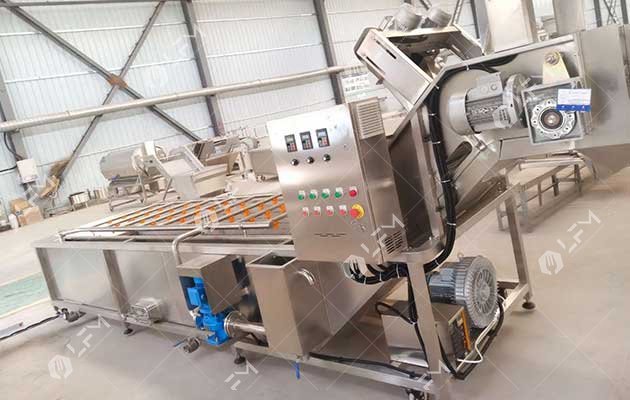What is The Safest Way to Wash Fruits and Vegetables?
In the modern food processing industry, washing fruits and vegetables is a key step in ensuring product safety, improving quality and extending shelf life. Especially in fruit and vegetable processing plants, washing is not only the first step to ensure food safety, but also the basis for the smooth progress of subsequent sorting, peeling, cutting and other processes. Although the traditional manual washing method has low cost, it has problems such as low efficiency and inconsistent cleanliness. So what is the safest way to wash fruits and vegetables?
Modern fruit and vegetable processing plants widely use automated cleaning equipment to improve efficiency, reduce labor costs, and improve cleanliness. Compared with traditional methods, industrial cleaning equipment has the following advantages:
High efficiency and automation: continuous operation, suitable for assembly line production;
Combination of multiple cleaning processes: such as bubbles, sprays, brushes, etc.;
Energy saving and environmental protection: the equipment is usually equipped with a water circulation filtration system to save water;
Customizable design: the cleaning solution can be customized according to different raw materials (size, epidermal morphology);
Improved safety: effectively remove harmful substances such as pesticide residues, bacteria, and mud.

Different equipment for different fruits and vegetables
Due to the variety of fruits and vegetables, different surface characteristics and fragility, the selection of cleaning equipment must also be tailored to the type of fruit and vegetable.
1. Root vegetables (such as potatoes and carrots)
These agricultural products have a lot of dirt on the surface, which makes them difficult to clean. Usually, a drum brush cleaning machine is used. This equipment uses the rotation of the drum and the friction of the brush to effectively remove mud, sand, and impurities on the skin. Some equipment also combines high-pressure water spraying or sand belt peeling, which is suitable for pre-processing before deep processing.
2. Leafy vegetables (such as spinach and lettuce)
Leafy vegetables are relatively delicate and are suitable for using a bubble cleaning machine. Bubble cleaning uses a bubbling device to generate a tumbling force, imitating the effect of "hand washing", which can clean the dirt and pesticides in the leaves without causing damage.
3. Fruits and vegetables (such as tomatoes and apples)
The skin is smooth but easily damaged, so it is advisable to use a brush spray cleaning machine. It is suitable for surface cleaning by using a soft brush and clean water spray.
4. Tropical fruits (such as mangoes and bananas)
These fruits need to be pre-treated to remove pectin and residual pesticides. They are often used in conjunction with ozone water cleaning systems, which have the dual functions of disinfection and sterilization, and are particularly suitable for the cleaning standards of export fruits.
Key elements of safe cleaning
Water source safety: treated clean water must be used to avoid secondary pollution;
Equipment hygiene management: equipment needs to be disinfected and cleaned regularly to prevent biofilm and bacterial colony accumulation;
Combination of sorting and detection systems: some advanced equipment is equipped with photoelectric sorting or manual assisted picking systems to further improve product quality.
Modern fruit and vegetable processing plants widely use automated cleaning equipment to improve efficiency, reduce labor costs, and improve cleanliness. Compared with traditional methods, industrial cleaning equipment has the following advantages:
High efficiency and automation: continuous operation, suitable for assembly line production;
Combination of multiple cleaning processes: such as bubbles, sprays, brushes, etc.;
Energy saving and environmental protection: the equipment is usually equipped with a water circulation filtration system to save water;
Customizable design: the cleaning solution can be customized according to different raw materials (size, epidermal morphology);
Improved safety: effectively remove harmful substances such as pesticide residues, bacteria, and mud.

Different equipment for different fruits and vegetables
Due to the variety of fruits and vegetables, different surface characteristics and fragility, the selection of cleaning equipment must also be tailored to the type of fruit and vegetable.
1. Root vegetables (such as potatoes and carrots)
These agricultural products have a lot of dirt on the surface, which makes them difficult to clean. Usually, a drum brush cleaning machine is used. This equipment uses the rotation of the drum and the friction of the brush to effectively remove mud, sand, and impurities on the skin. Some equipment also combines high-pressure water spraying or sand belt peeling, which is suitable for pre-processing before deep processing.
2. Leafy vegetables (such as spinach and lettuce)
Leafy vegetables are relatively delicate and are suitable for using a bubble cleaning machine. Bubble cleaning uses a bubbling device to generate a tumbling force, imitating the effect of "hand washing", which can clean the dirt and pesticides in the leaves without causing damage.
3. Fruits and vegetables (such as tomatoes and apples)
The skin is smooth but easily damaged, so it is advisable to use a brush spray cleaning machine. It is suitable for surface cleaning by using a soft brush and clean water spray.
4. Tropical fruits (such as mangoes and bananas)
These fruits need to be pre-treated to remove pectin and residual pesticides. They are often used in conjunction with ozone water cleaning systems, which have the dual functions of disinfection and sterilization, and are particularly suitable for the cleaning standards of export fruits.
Key elements of safe cleaning
Water source safety: treated clean water must be used to avoid secondary pollution;
Equipment hygiene management: equipment needs to be disinfected and cleaned regularly to prevent biofilm and bacterial colony accumulation;
Combination of sorting and detection systems: some advanced equipment is equipped with photoelectric sorting or manual assisted picking systems to further improve product quality.
- Prev:Analysis of Centrifugal Deoiling Machine Price
- Next:None
Leave Your Message
If you are interested in our machine or any question, don't hesitate to contact us.
